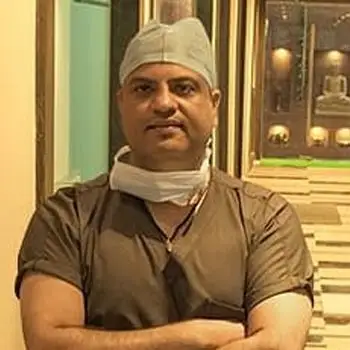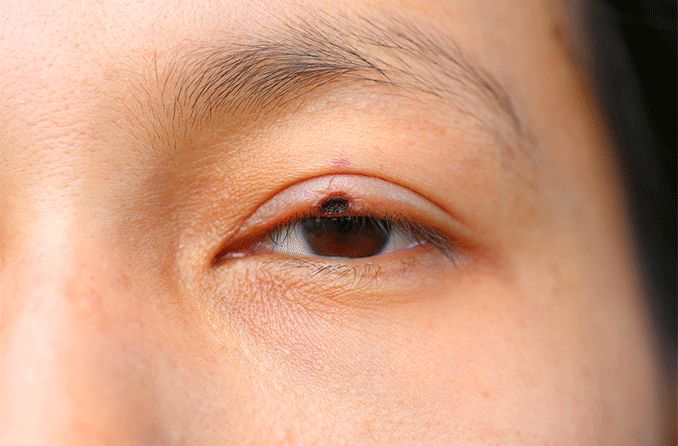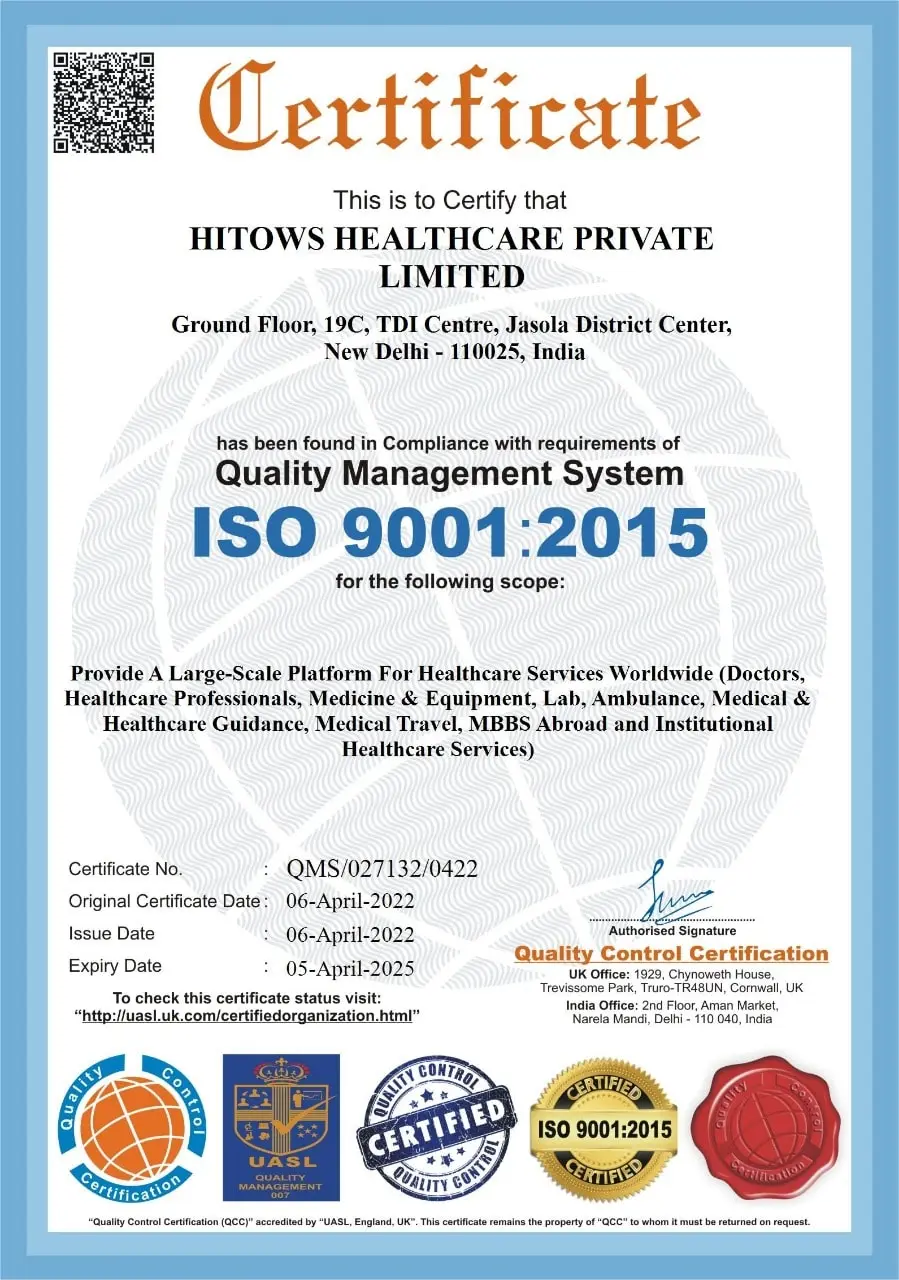ORBIT AND OCULOPLASTY Small Lid Tumor/ Cyst excision Single Eye
India
-
Our Price USD 350
-
Hospital Price USD 368
-
You Save : USD 18
Booking Amount: USD 35. Pay Remaining 90% at the hospital.
Book NowAdditional Credit
Among the important extras we offer as part of the Additional Credit are the following:
-
Site Tourism For The Patient & Attendant
-
Airport Pick & Drop Service
-
Ambulance service at airport
-
Priority appointments with The Doctor
-
Cancel Easily Anytime with Full Refund
-
Room Upgradation
-
Free Online Doctor Consultation Valued at USD 20
-
Free hotel Stay for 5 to 7 days Accordingly
-
Welcome Kit at Arrival
-
Interpreter
-
Medical Visa Assistance
What is Included?
- Doctor consultation charges
- Lab tests and diagnostic charges
- Room charges inside hospital during the procedure
- Surgeon Fee
- Cost of implant
- Nursing charges
- Hospital surgery suite charges
- Anesthesia charges
- Routine medicines and routine consumables (bandages, dressings etc.)
- Food and Beverages inside hospital stay for patient and one attendant.
What is not Included?
- Extra Radiology Investigations
- Healthcare Professionals Charges of other consultations.
- Other Requested Services such as Laundry etc.
- Additional Pharmaceutical Products and Medicines After Discharge from Hospital.
- Management of Conditions Unrelated to Procedures or Pre-Existing.
- The cost of any additional implants will be in addition to the package cost.
Package Description
ORBIT AND OCULOPLASTY Small Lid Tumor/ Cyst excision
Eyelid tumours are noncancerous growths around the eyes that can be benign or cancerous. While basal cell carcinoma is the most prevalent form of malignant tumour on the eyelid, it is not the only one. Simple cysts or styes (chalazia) are examples of benign growths.
Sebaceous (fat), sweat, or apocrine glands, which are a kind of sweat gland, can all cause an eyelid tumour. Basal cell carcinoma is the most prevalent kind of cancer that develops on the eyelid.
The majority of eyelid lesions are benign. An ophthalmologist's accurate diagnosis is based on the patient's medical history and clinical examination. Any suspicious lesion should be biopsyed if in question. In this article, we'll go through some of the most frequent eyelid lesions that an ophthalmologist could see in general practise.
The objective of surgery should be to completely remove the malignancy. Primary excision is generally performed using either frozen section control or Moh's approach.
Disease Overview:
Cyst in Eyelid
The eyelids include specialised oil-producing glands (meibomian glands) that secrete their secretions onto the eye's surface, preventing the tear film from evaporating too fast.
If the meibomian glands' ducts get clogged, the ensuing accumulation of oils may behave as a 'foreign body,' causing an inflammatory reaction and a quickly developing reddish mass in the eyelid. When there is concomitant inflammation of the eyelid margins, this is more likely to happen (blepharitis). There may be two or more cysts in a single lid, and more than one eyelid may be implicated in certain cases.
The inflammation usually goes away on its own over time, leaving a smaller but more solid pea-sized lump in the eyelid known as a "chalazion" or "meibomian cyst." These lumps or cysts might take a long time to resolve, but if they don't go away on their own, they usually need to be surgically removed.
Disease Signs and Symptoms:
You will notice the following symptoms if you have a chalazion: A painless lump on the upper lid of your eyelid. Irritation that makes your eyes wet. Larger chalazia pushing on the eyeball cause blurred vision.
Disease Causes:
Blepharitis and lid cysts are more prevalent among fair-skinned Scandinavian and Caucasian people, and they can affect anybody at any age. Blepharitis and cyst development are caused by a variety of reasons, according to patients. Lack of sleep,'stress' at work or at home, dehydration, prolonged VDU use, air-conditioned workplaces, and, in some situations, even alcohol are among them. However, there is little data to support or disprove these theories.
Disease Diagnosis:
A full eye exam is required to diagnose a chalazion. Your optometrist or medical provider will begin by gathering information about your medical history in order to better understand your symptoms and any health conditions that may be contributing to your eyelid difficulties.
Your doctor will then inspect your eyes, paying special attention to the structure of your eyelids, the texture of your skin, and the appearance of your eyelashes. This is usually enough evidence to make a clinical diagnosis, however the doctor may take a sample of fluid from the chalazion for laboratory testing on rare occasions.
Disease Treatment:
In those at risk, regular lid hygiene with warm compresses and topical antibiotic ointment applied to the eyelid edges lowers the incidence of chalazion development. Cysts that have already formed may respond to this therapy, but those that do not require an incision and curettage will need to be removed. Omega oils (found in Flax seed oil supplements, for example) are considered to promote glandular activity in the lids, lowering the likelihood of oil buildup and cyst development. The function of the meibomian glands can also be improved with the use of a "Eye Bag."
curettage and incision
The contents of the cyst are released during this treatment. This causes the inflammation to go away quickly, and normal glandular activity in the lids to return.
The contents of the cyst are discharged from the inside surface of the lid after a little dose of local anaesthesia is administered beneath the skin of the eyelid (this avoids a skin incision and a visible scar). The cyst may recur in a tiny percentage of individuals, necessitating reoperation.
Information related to Treatment
Package Details
Days in Hospital
1 Days
Days in Hotel
*
2 Days
Room Type
Private

Treating Doctor
Dr. Suraj Munjal
Ophthalmologist- Retina Surgeon, Cataract Surgeon, Lasik surgeon, Vitreo Retina Surgeon, Eyelid Surgery, Trabeculectomy, Vitreoretinal Surgery, Orbital & Oculoplastic surgery, Refractive surgery, Retina Examination, Glaucoma Evaluation / Treatment, Canaloplasty, Corneal Surgery, Eye Muscle Surgery, Orbital Surgery, Anterior Segment Surgery, Orbital Decompression Surgery for Thyroid Eye Disease, Orbital Trauma, Diabetic Retinopahy, YAG laser Posterior Capsulotomy, Anterior Retinal Cryotherapy, Retinal Surgery, Lens for Keratoconus
The Sight Avenue Eye Hospital Delhi, India
19 Years of Experience


